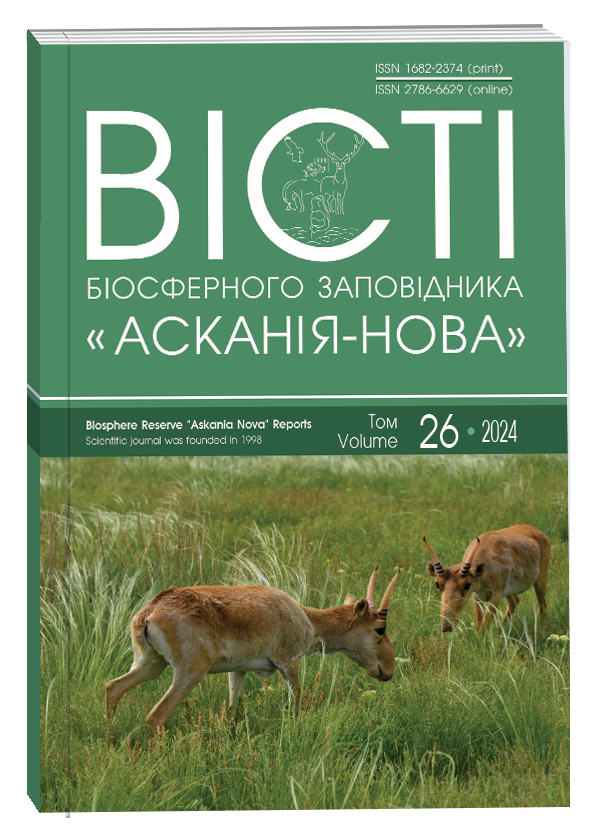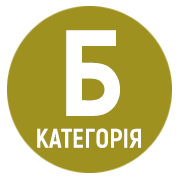PRE-OCCUPATION STATUS OF HABITATS IN THE BIOSPHERE RESERVE "ASKANIA NOVA": INVENTORY AND MAPPING USING REMOTE SENSING AND MACHINE LEARNING
DOI:
https://doi.org/10.53904/1682-2374/2024-26/5Keywords:
Картування, біотопи, дистанційне зондування Землі, степ, УкраїнаAbstract
Mapping habitats is an essential component of assessing the condition of natural ecosystems. However, accomplishing this task using traditional field methods requires extensive human efforts and financial resources. An alternative is remote habitat mapping using satellite imagery and classification algorithms. In the context of war and the temporary occupation of parts of Ukraine, remote habitat mapping often becomes the only feasible method to obtain a snapshot of ecosystem conditions. We developed a habitat classification scheme for the territory of the Biosphere Reserve "Askania Nova" (Kherson region, Ukraine) based on the national classification system, with certain modifications and refinements that account for the land use forms and practices specific to that area. Using field survey data collected within the Reserve before the temporary occupation, combined with image segmentation methods and supervised classification of Sentinel-2 satellite data, we composed detailed habitat maps for the entire Reserve (including the natural core, buffer, and anthropogenic landscape zones). The results demonstrate that the prevalent habitat types include continuous croplands (both rainfed and irrigated), true forb-bunchgrass and bunchgrass steppes of the steppe zone, fallow or recently abandoned arable lands, and temporary saline wetlands in depressions of the steppe zone (pody). Integrating direct earth observation data with derived metrics reflecting the phenology of plant communities proved highly effective for habitat mapping. Object-based and pixel-based classifications provided equally fair results, although object-based methods minimised issues of class interference caused by misclassification of individual pixels (the "salt-and-pepper problem"). The open-source scripts in R and Python, provided as supplementary materials, ensure the reproducibility of this method in other areas. The resulting maps represent a reliable snapshot of the pre-occupation state of the Biosphere Reserve "Askania Nova" habitats and serve as a spatially explicit foundation for their future monitoring and change detection.
References
Біотопи степової зони України / Ред. академік НАН України Я.П. Дідух. Київ–Чернівці : Друк Арт, 2020. 392 с.
Веденьков Е.П., Веденькова А.Г. Современное состояние и динамика растительности старейшего заповедного участка асканийской степи. Актуальні питання збереження і відновлення степових екосистем : матер. міжнар. наук. конф., присв. 100-річчю заповідання асканійського степу (Асканія-Нова, 21–23 травня 1998 р.). Асканія-Нова : 1998. С. 20–25.
Веденьков Е.П., Водопьянова В.Г. Результаты изучения растительности заповедной степи Аскании-Нова. Труды Украинского научно-исследовательского института животноводства степных районов им. М.Ф. Иванова "Аскания-Нова". 1969. Т. XIV. С. 75–100.
Веденьков Е.П., Ющенко А.К. Заповедник Аскания-Нова. Заповедники СССР. Заповедники Украины и Молдавии. Москва : Мысль, 1987. С. 114–138.
Десятова-Шостенко Н. Ботанічне обслідування степів Держзаповідника "Чаплі" (кол. Асканія-Нова) на весні 1927 р. Вісті Державного Степового Заповідника "Чаплі". 1928. Т. VII. С. 153–163.
Дмитриев А.М. Луговодство с основами луговедения. Москва : Сельхозгиз, 1941. 351 с.
Дубина Д.В., Устименко П.М. Карта рослинності заповідного масиву "Долина нарцисів" (Закарпатська обл.). Український ботанічний журнал. 2007. № 4. С. 553–565.
Короткова Е.И. Динамика растительного покрова южноукраинской степи по наблюдениям в Аскании-Нова: дис... канд. биол. наук : 03.00.05. 1964. 243 с.
Національний каталог біотопів України / За ред. А.А. Куземко та ін. Київ : ФОП Клименко Ю.Я., 2018. 442 с.
Спінова Ю. Картування біотопів в аспекті формування локальних екомереж на прикладі природного заповідника "Крейдова флора". Наукові записки НаУКМА. Біологія та екологія. 2021. Т. 4. С. 47–50.
Тищенко О.В., Тищенко В.М., Ткаченко В.С. Зміни рослинного покриву лесового острова Степок (Запорізька область) за 92-річний відтинок часу (1927–1999–2019). Вісті Біосферного заповідника "Асканія-Нова". 2020. Т. 22. С. 4–9.
Ткаченко В.С., Шаповал В.В. Cукцесії фітосистем ділянки "Північна" новоасканійського заповідного степу у другій половині XX і на початку XXI ст. Вісті Біосферного заповідника "Асканія-Нова". 2010. С. 21–32.
Устименко П.М., Климук Ю.В. Карта рослинності природного заповідника "Горгани" як основа фітоценотичного моніторингу. Український ботанічний журнал. 2006. Т. 63. № 3. С. 470–479.
Шалыт М.С. Растительность степей Аскании-Нова. Известия Крымского Педагогического института имени М.В. Фрунзе. 1938. Т. VII. С. 45–133.
Шаповал В.В. Сучасний стан та структура рослинності найстарішої ділянки асканійського степу – "Старої" (охороняється з 1898 р.). Вісті Біосферного заповідника "Асканія-Нова". 2013. Т. 15. С. 22–39.
Шаповал В.В. Матеріали до картографічного моніторингу постпірогенних сукцесій рослинності асканійського степу. Вісті Біосферного заповідника "Асканія-Нова". 2018. Т. 20. С. 15–21.
Abdi A.M. Land cover and land use classification performance of machine learning algorithms in a boreal landscape using Sentinel-2 data. GIScience & Remote Sensing. 2020. Vol. 57, № 1. P. 1–20.
Abdulloieva O. MP EmS "NNP Pyriatinskyi". 2017.
Achanta R., Susstrunk S. Superpixels and polygons using simple non-iterative clustering. Proceedings of the IEEE conference on computer vision and pattern recognition (CVPR), 2017. Р. 4651–4660.
Alleaume S., Dusseux P., Thierion V., Commagnac L., Laventure S., Lang M., Féret J.-B., Hubert-Moy L., Luque S. A generic remote sensing approach to derive operational essential biodiversity variables (EBVs) for conservation planning. Methods in Ecology and Evolution. 2018. Vol. 9, № 8. P. 1822–1836.
Boser B.E., Guyon I.M., Vapnik V.N. A training algorithm for optimal margin classifiers. Proceedings of the fifth annual workshop on Computational learning theory. Pittsburgh Pennsylvania USA : ACM, 1992. P. 144–152.
Breiman L., Friedman J., Olshen R., Stone C. Classification and regression trees. New York : Wadsworth Publishing, 1984. 368 p.
Chytrý M., Tichý L., Hennekens S.M., Knollová I., Janssen J.A.M., Schaminée J.H.J., et al. EUNIS Habitat Classification: Expert system, characteristic species combinations and distribution maps of European habitats. Applied Vegetation Science. 2020. Vol. 23, N 4. P. 648–675.
Davydova A. Vegetation mapping of the Dzharylhach Island (Ukraine). Hacquetia. 2022. Vol. 21, № 1. P. 163–172.
Dronova I. Object-Based Image Analysis in Wetland Research: A Review. Remote Sensing. 2015. Vol. 7, № 5. P. 6380–6413.
Esri. World Imagery basemap [Data provided by Esri, Maxar, Earthstar Geographics, and the GIS User Community]. 2024.
EUNIS habitat classification 2012 – updated 2019 as regards two habitats. European Environment Agency 2019. https://www.eea.europa.eu/data-and-maps/data/eunis-habitat-classification-1/habitats
Gislason P.O., Benediktsson J.A., Sveinsson J.R. Random Forests for land cover classification. Pattern Recognition Letters. 2006. Vol. 27, № 4. P. 294–300.
Gorelick N., Hancher M., Dixon M., Ilyushchenko S., Thau D., Moore R. Google Earth Engine: Planetary-scale geospatial analysis for everyone. Remote Sensing of Environment. 2017. Vol. 202. P. 18–27.
Guth J., Kučera T. Natura 2000 habitat mapping in the Czech Republic: methods and general results. Ekológia (Bratislava). 2005. Vol. 24, № 1. P. 39–51.
Hengl T., Walsh M.G., Sanderman J., Wheeler I., Harrison S.P., Prentice I.C. Global mapping of potential natural vegetation: an assessment of machine learning algorithms for estimating land potential. PeerJ. 2018. Vol. 6. P. e5457.
Hermosilla T., Wulder M.A., White J.C., Coops N.C. Land cover classification in an era of big and open data: Optimizing localized implementation and training data selection to improve mapping outcomes. Remote Sensing of Environment. 2022. Vol. 268. P. 112780.
Hijmans R.J. terra: Spatial Data Analysis. 2024.
Ho T.K. Random decision forests. Proceedings of 3rd international conference on document analysis and recognition: IEEE, 1995. P. 278–282.
Kuzemko A. Ukrainian Grasslands Database. Biodiversity & Ecology. 2012. Vol. 4. P. 430–430.
Kuzemko A., Prylutskyi O., Kolomytsev G., Didukh Y., Moysiyenko I., Borsukevych L., Chusova O., Splodytel A., Khodosovtsev O. Reach the bottom: plant cover of the former Kakhovka Reservoir, Ukraine. Research Square. 2024.
Lucas R., Rowlands A., Brown A., Keyworth S., Bunting P. Rule-based classification of multitemporal satellite imagery for habitat and agricultural land cover mapping. ISPRS Journal of photogrammetry and remote sensing. 2007. Vol. 62, № 3. P. 165–185.
Matsala M., Odruzhenko A., Hinchuk T., Myroniuk V., Drobyshev I., Sydorenko S., Zibtsev S., Milakovsky B., Schepaschenko D., Kraxner F., Bilous A. War drives forest fire risks and highlights the need for more ecologically-sound forest management in post-war Ukraine. Scientific Reports. 2024. Vol. 14, № 1. P. 4131.
McFeeters S.K. The use of the Normalized Difference Water Index (NDWI) in the delineation of open water features. International journal of remote sensing. 1996. Vol. 17, № 7. P. 1425–1432.
Myroniuk V., Weinreich A., Dosky V. von, Melnychenko V., Shamrai A., Matsala M., Gregory M.J., Bell D.M., Davis R. Nationwide remote sensing framework for forest resource assessment in war-affected Ukraine. Forest Ecology and Management. 2024. Vol. 569. P. 122156.
Pebesma E. Simple features for R: standardized support for spatial vector data. The R Journal. 2018. Vol. 10, № 1. P. 439–446.
Python Software Foundation. Python Language Reference. 2024.
QGIS Development Team. QGIS Geographic Information System. Open Source Geospatial Foundation Project. http://qgis.osgeo.org. 2024.
R Core Team. R: A language and environment for statistical computing. 2024.
Rouse J.W., Haas R.H., Schell J.A., Deering D.W. Monitoring vegetation systems in the Great Plains with ERTS. Third earth resource technology satellite-1 symposium. Washington, D.C. : NASA, 1974. P. 309–318.
Ruiz L.F.C., Guasselli L.A., Simioni J.P.D., Belloli T.F., Barros Fernandes P.C. Object-based classification of vegetation species in a subtropical wetland using Sentinel-1 and Sentinel-2A images. Science of Remote Sensing. 2021. Vol. 3. P. 100017.
Shapoval V., Skobel N., Vasyliuk O. Records of vascular plants, bryophytes and lichens in the core of the Askania-Nova Biosphere Reserve F.E. Falz-Fein and depressions lands based on relevés in 1967–2019. Version 1.1. 2024. Ukrainian Nature Conservation Group (NGO). Sampling event dataset https://doi.org/10.15468/m4u6mx 2024.
Shevchuk S., Vyshnevskyi V.I., Bilous O. The Use of Remote Sensing Data for Investigation of Environmental Consequences of Russia-Ukraine War. Journal of Landscape Ecology. 2022. Vol. 15, № 3. P. 36–53.
Tassi A., Vizzari M. Object-Oriented LULC Classification in Google Earth Engine Combining SNIC, GLCM, and Machine Learning Algorithms. Remote Sensing. 2020. Vol. 12, № 22. P. 3776.
Yang X., Qiu S., Zhu Z., Rittenhouse C., Riordan D., Cullerton M. Mapping understory plant communities in deciduous forests from Sentinel-2 time series. Remote Sensing of Environment. 2023. Vol. 293. P. 113601.







